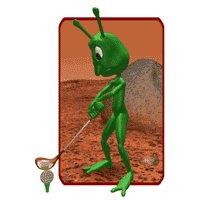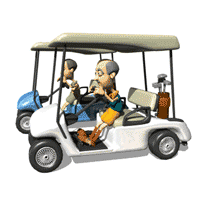  |
  |


Art Bell I live by the golf course and almost eveynight there are UFOs at the links . I have it figured out why the UFOs come back everynight. It is for the 9th hole on the golf course.
The exact origins of the game of golf remain a subject of continual debate. Although Scotland is generally considered as the birthplace of the game, as it is played today. This claim is due in large part to a number of specific historical references dating as far back as the mid 1400s.
The most commonly cited of these references is a written record that a games called either geoff, gowf or gawd , this is a hard game was played during the reign of James II of Scotland. In 1457 King James proclaimed by royal decree that the playing of “fluteball : and “gowf” were forbidden so that the men of Scotland could concentrate on their archery practice.
Thus the pursuit of golf remained outlawed until the signing of the Treaty of Glasgow in the year of `1501 m which brought peace between the warring parties. At this point even Scotland James IV took up the game of golf himself. A long relationship between golf and royalty ensued – although both commoners and gentry alike frowned upon Mary Queen of Scots when, in 1567 was found to be playing golf just days after the death of her husband Darney.
In an alternate theory of golf’s beginnings, a Dutch historian, Steven von Hengel, has argued that golf originated in Holland around 1297. A form of the game called spel metten kove and also called Colf. Colf, it is believed, was played primarily on ice. Nevertheless golf may have grown out of this game and another game that was popular in Holland, called Jeu De Mail. This letter carrying game was played in wooden shoes with soft spikes.
Without question golf’s major growth occurred in Great Britain, primarily in Scotland. Golf became an accepted part of the culture as early as 1604, when William Mayne was appointed Royal Clubmaker, although the game was still reserved for the elite who had the wealth and leisure to enjoy it. Early golf was played with a feathery golf ball - a stitched leather ball stuffed with boiled goose feathers. A feather ball cost three times as much as a club and because feathery balls were so delicate, players had to carry three to six balls In addition the balls flew poorly in wet weather, a fact that further dissuaded the working class who, unlike the gentry did not possess the flexibility of flexible time and leisure for scheduled games of golf.
The ball, as it has throughout history, dictated other matters pertaining to the development of the game. Because the feathery ball performed so inadequately when damp, early golf was played predominantly on the relatively arid eastern side of Scotland. Furthermore the eastern seaside location was popular because the underlying sandy soil drained more rapidly than the and the grass was naturally shorter. It must be noted that the invention of the lawn mower is a relatively current occurrence. Along the way this short grassed seaside golfing location came to be too referred to as links.
If the debate over whether the Scots or Dutch created the game of golf, the Scots certainly had a hand in creating the golf club. Leith is considered the birthplace of organized golf, and the golf club called the Honorable Company of Gentleman Golfers was founded by William St. Clair in Leith in 1744 and later became the Company of Edinburgh Golfers. Ten years later, the Royal and Ancient Golf Company was founded under it original name, the Society of St. Andrews Golfers. The Royal and Ancient Golf Club runs the British Open and British Amateur duties that it assumed in 1919 , and since 1951 has administered the rules of golf in cooperation with the United States Golf Association. The R & A also established 18 holes as the standard golf course. In 1764, the Old Course at St. Andrews consisted of 22 holes with golfers playing 11 holes out and 11 back. Eventually the last 4 holes on each side, all short converted into 2 holes leaving 18 to be played.
Thus is the history and origins of our modern game of golf that we treasure today.

| © RIYAN Productions |